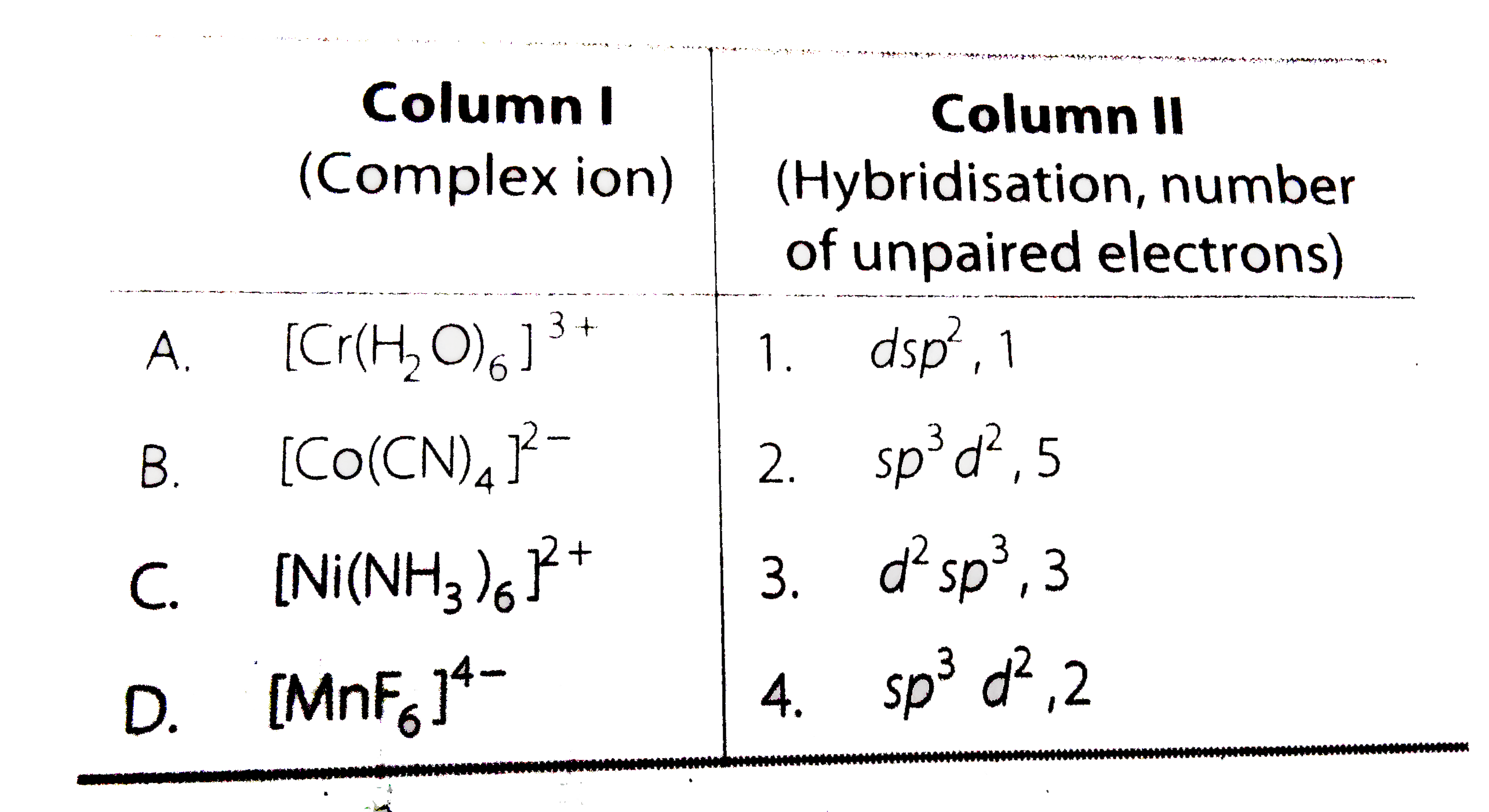Nickel (Z = 28) combines with a uninegative monodentate ligand to form a diamagnetic complex [NiL4]2− . The hybridisation involved and the number of unpaired electrons presents in the complex are respectively:
sp3, two
dsp2,zero
dsp2, one
sp3, zero
The correct Answer is:B
Step by step video & image solution for Nickel (Z = 28) combines with a uninegative monodentate ligand to form a diamagnetic complex [NiL_4]^(2-) . The hybridisation involved and the number of unpaired electrons presents in the complex are respectively: by Chemistry experts to help you in doubts & scoring excellent marks in Class 12 exams.
Updated on:21/07/2023Topper's Solved these Questions
- COORDINATION COMPOUNDSBOOK - RESONANCE ENGLISHCHAPTER - COORDINATION COMPOUNDSEXERCISE - Additional Problem for Self Practice (APSP) Part-I
29 Videos
- COORDINATION COMPOUNDSBOOK - RESONANCE ENGLISHCHAPTER - COORDINATION COMPOUNDSEXERCISE - Additional Problem for Self Practice (APSP) Part-II
61 Videos
- COORDINATION COMPOUNDSBOOK - RESONANCE ENGLISHCHAPTER - COORDINATION COMPOUNDSEXERCISE - Exercise-3 Part-II: JEE(Main ) /AIEEE Problem
36 Videos
- CHEMISTRY IN EVERYDAY LIFEBOOK - RESONANCE ENGLISHCHAPTER - CHEMISTRY IN EVERYDAY LIFEEXERCISE - ORGANIC CHEMISTRY(Chemistry in every day life)
31 Videos
- D & F BLOCK ELEMENTSBOOK - RESONANCE ENGLISHCHAPTER - D & F BLOCK ELEMENTSEXERCISE - ORGANIC CHEMISTRY(Aldehydes , Ketones, Carboxylic acid)
15 Videos
Similar Questions
Nickel (Z=28) combines with a uninegative monodenatate ligands to form a diamagnetic complex [NiL4]2−. The hybridisation involved and the number of unpaired electrons present in the complex are respectively:
View SolutionNickel (Z=28) combines with a uninegative monodentate ligand X− to form a paramagnetic complex [NiX4]2−. The number of unpaired electron(s) in the nickel and geometry of this complex ion are, respectively:
View SolutionThe number of unpaired electrons present in complex ion [FeF6]3− is:
View SolutionVelence bond theroy describes the bonding in complexs in terms of coordinate -covalent bond resulting from overlap filled ligand orbitals with vacant metal hybrid orbitals This theory explains magnetic behaviour and geometrical shape of coordination compounds Magnetic moment of a complex compound can be determined experimentally and theoretically by using spin only formula
Magnetic moment √n(n+2)BM (where n = No. unpaired electrons) .
Ni2+ cation combines with a uninegative monodentate ligand XΘ to form paramagnetic complex [NiCI4]2− The number of unpaired electrons(s) in central metal cation and geometry of this complex respectively are
(a) One,tetrahedral
(b) Two,tetrahedral
(c ) One,square planar
(d) Two, square planar .
View SolutionIn hexacyanidomanganate(II) ion the Mn atom assumes d2sp3- hybrid sates. Then the number of unpaired electrons in the complex is .
View SolutionHexafluorocobaltate (III) ion is an outer orbital complex. The
number of unpaired electrons present in it is
View SolutionMatch the complex ions given in column I with the hybridisation and number of unpaired electrons given in column II and assign the correct code

View SolutionBoth [Ni(CO)4] and [Ni(CN)4]2− are diamagnetic The hybridisations of nickel in these complexes , respectively are :
View SolutionConsider the following complex [Co(NH3)5CO3]ClO4
The coordination number, oxidation number number of d-electrons and number of unpaired d-electrons on the metal are respectively
View SolutionConsider the following complex [Co(NH3)5CO3]ClO4
The coordination number, oxidation number number of d-electrons and number of unpaired d-electrons on the metal are respectively
View Solution
